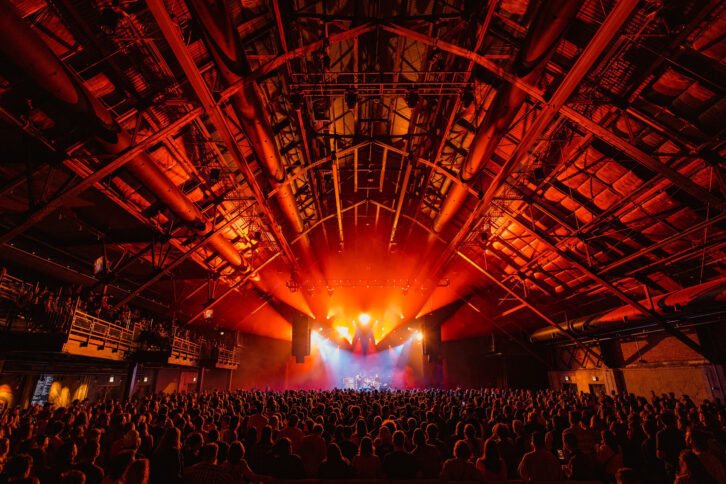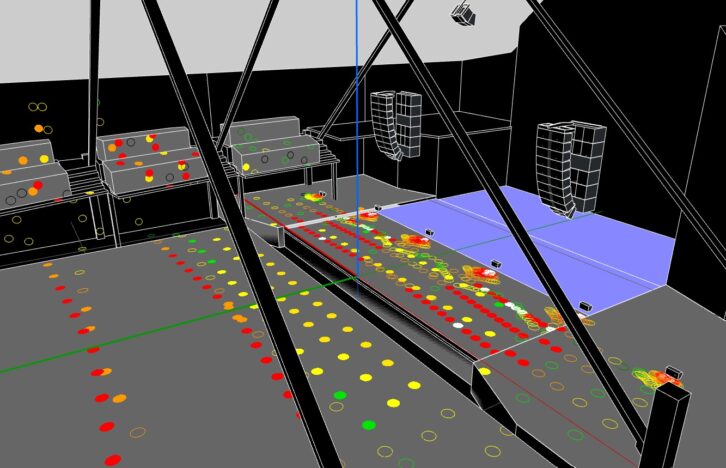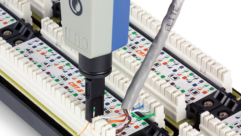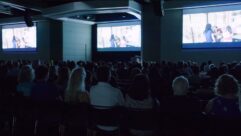
Software shows up in sound reinforcement in many ways, from driver design to DSP, all the way to the shaping of a venue and the experiences people will have there, the memories they will take away. Let’s look at two examples, one where L-Acoustics’ Soundvision combined with responsive hardware to foresee an optimal room for a landmark music venue. In the other install, the software/ hardware intelligence of Meyer Sound Constellation proves once again why it was a groundbreaking and prescient tool more than 15 years ago, now and into the future.
For nearly a hundred years, Chicago’s Morton Salt warehouse, sandwiched between the Kennedy Expressway and Goose Island, has been a familiar fixture on the city’s north side. Now, thanks to the vision of 16” On Center (16OC), along with local developer Blue Star Properties, the former Morton Salt facility has metamorphosed into a new entertainment complex known as the Salt Shed, with live music as its bread and butter and a new L-Acoustics K2 professional audio system, designed and installed by local L-Acoustics Certified Provider integrator (CPi) OSA International.
Salt Shed Production Manager Tim Schoen wanted to up the ante and really stand out in a town with a lot of great sounding rooms and rigs. He turned to OSA and L-Acoustics to create a Soundvision model of the Shed, which proved to be a challenging environment to control sonically. “The Shed is basically a long, skinny shoebox, a couple hundred feet deep, with a trapezoidal roof and tons of reflective surfaces,” he describes. “We brought in acoustician Steven Sockey of Truephonic, who made some excellent recommendations about installing lapendary panels across the ceiling and other sound absorption treatments throughout the space, but the adjustable directivity of the K2 arrays and A15 delays proved to be equally important to the room’s success.”
Brandon Gardner, OSA Director of AV Integration – Professional Systems, agrees: “Being able to adjust and refine the directionality of the PA with L-Acoustics’ Panflex feature was immensely helpful. The top enclosures of the K2 arrays are set to 70 degrees, some of the middles are at 90, and the bottoms are at 110, which was instrumental in keeping sound off the walls. And with a premium balcony at house left, we could easily custom-tailor the arrays onsite to avoid those potential reflections.”
 Installed in January, Salt Shed’s concert sound loudspeaker complement features left and right main hangs of nine L-Acoustics K2 over three Kara II downs, with a flown center-fill comprised of one A15 Focus and one A15 Wide. Four KS28 subs are flown behind each main array, while another four enclosures are on the ground in front of center stage. Half a dozen X8 spread out across the stage lip deliver front-fill, while stage left and right pairings of a single A15 Focus and KS21 provide side-fill. Thirteen X15 HiQ wedges and one KS21 sub offer stage monitoring, and at the far end of the room, two hangs of A15i Focus and A15i Wide serve as delays. The house and monitor systems are each piloted by DiGiCo Quantum338 consoles paired with SD-Racks loaded with 32-bit I/O modules, and the entire loudspeaker setup is driven via AVB with a P1 processor and eight LA7.16i and three LA12X amplified controllers.
Installed in January, Salt Shed’s concert sound loudspeaker complement features left and right main hangs of nine L-Acoustics K2 over three Kara II downs, with a flown center-fill comprised of one A15 Focus and one A15 Wide. Four KS28 subs are flown behind each main array, while another four enclosures are on the ground in front of center stage. Half a dozen X8 spread out across the stage lip deliver front-fill, while stage left and right pairings of a single A15 Focus and KS21 provide side-fill. Thirteen X15 HiQ wedges and one KS21 sub offer stage monitoring, and at the far end of the room, two hangs of A15i Focus and A15i Wide serve as delays. The house and monitor systems are each piloted by DiGiCo Quantum338 consoles paired with SD-Racks loaded with 32-bit I/O modules, and the entire loudspeaker setup is driven via AVB with a P1 processor and eight LA7.16i and three LA12X amplified controllers.
The project notably represented the first major US deployment of L-Acoustics’ new LA7.16i amplified controller on a system of this size. “We’re using three LA7.16i per side on the left and right hangs, so each amplifier is driving four K2 or Kara II and providing individual box control, greatly improving the response across the room,” shares Gardner. “We would have needed twice as many amplifiers for each hang if it wasn’t for this product, which packs a lot of channels and power into only 2U. We’re using just one of them to drive the fill speakers, so it’s doing all the X8 and X15, which was really easy and saved us rack space.”
“I’m probably pretty biased, but I’d say that this is now the best-sounding system in Chicago,” he continues. “Audio-wise, there’s not a bad spot in the room, from the stage all the way up to the balcony’s back row, which can be a surprise because it’s a cavernous venue. I’ve heard people say that they were expecting the room to sound brutal with lots of reflections, but the space is well controlled. 16” On Center paid a lot of attention to detail in preserving the visual aesthetic of this historic structure, but it only looks like a big shed—it doesn’t sound like one.”
“We’re a rock venue first and foremost, so we wanted that visceral sound experience, but not at a tradeoff to fidelity,” Schoen adds. Being able to walk around the entire venue and get the same clarity and punch everywhere is just surreal. And when I’m at front-of-house with my SPL meter reading that we’re at 105dB, yet it seems like 90dB, and the system isn’t even sweating, that’s also amazing. It’s like looking at the speedometer in a Lamborghini and thinking, ‘I didn’t realize I was going that fast.’”
 Despite its reputation as a global mecca for entertainment, Las Vegas had struggled in recent years to support a thriving art house cinema. That deficiency was remedied earlier this year with the opening of The Beverly Theater, a multi-dimensional event venue that leverages the best-in-class AVL systems designed by Coherent Design and installed by Solotech, including the sonic flexibility of Meyer Sound’s Constellation acoustic system to create audience experiences that extend far beyond traditional film showings, and adapting the sonic atmosphere of the room to each event.
Despite its reputation as a global mecca for entertainment, Las Vegas had struggled in recent years to support a thriving art house cinema. That deficiency was remedied earlier this year with the opening of The Beverly Theater, a multi-dimensional event venue that leverages the best-in-class AVL systems designed by Coherent Design and installed by Solotech, including the sonic flexibility of Meyer Sound’s Constellation acoustic system to create audience experiences that extend far beyond traditional film showings, and adapting the sonic atmosphere of the room to each event.
“Beverly Rogers, the visionary and namesake behind this theater, had a dream for a storytelling arena that would host cinematic, literary, and live music events in one accommodating space,” says Kip Kelly, founding creative director and chief experience officer for The Beverly Theater. “Since those events all require different acoustics for uncompromised presentations, Constellation became a foundational technology in the design. The things we can do here with Constellation you will not find in even the best art house cinemas elsewhere. In fact, I think we have a model for what art houses will aim to be in the future, both in terms of the technology and how we use it to create memorable events.”
The physical room acoustics are deadened to best accommodate cinema, but by selecting a touchscreen preset the Constellation can implement voice lift, which allows spoken word intelligibility throughout the space — from presenters or audience members — without individual hand-held microphones. The 146 theater seats are retractable, opening the floor to accommodate over 400 for a wide variety of events, including live music. Constellation has presets to optimize the room acoustic for any genre, from choral to orchestral and jazz.
 “Voice lift has helped us turn film showings into special events,” continues Kelly. “We can bring in creative people and cast members to engage with the audience, something you won’t get when streaming the film at home.”
“Voice lift has helped us turn film showings into special events,” continues Kelly. “We can bring in creative people and cast members to engage with the audience, something you won’t get when streaming the film at home.”
All audio, video, and stage lighting (AVL) technologies were designed by Las Vegas-based Coherent Design under the direction of Principals Kevin Potts, David Starck, Jarrod Hetzer (theatrical lighting), and Jason Pritchard (AV).
“When the principals at the Rogers Foundation — the theater’s owner — explained to me what they wanted to do, I immediately thought of a Meyer Sound cinema system coupled with Constellation,” says Potts. “When we visited Meyer Sound’s Pearson Theater in Berkeley and heard the Constellation demo, they were immediately sold on the concept. It didn’t take much convincing.”
For film showings, the cinema system is anchored in the front by three Acheron 100 screen channel loudspeakers along with six X-800C cinema subwoofers for LFE. Fourteen ULTRA-X20XP compact wide coverage loudspeakers provide 7.1 surround capability and also integrate with Constellation active acoustics.
Constellation utilizes an additional 63 fullrange loudspeakers (Ashby-5C and MM-4XP) along with 16 MM-10XP subwoofers. Forty-nine mini condenser microphones are deployed for ambient sensing, all on automated cable reels to precisely raise and lower depending on the current room mode – typically music presets with flat floor or voice lift with raked theater seating.
Supplier and integrator for all AVL systems was Solotech, a leader in audiovisual and entertainment technology, established in Las Vegas since 2007, with coordination by Business Development Manager Aaron Beck, on-site project management by Jason Bauer, and systems programming by Eric McFall.
 For events on the adjoining outdoor terrace, the venue also has a portable system with two ULTRA-X40 compact loudspeakers, normally pole-mounted on two 900-LFC subwoofers set on caster frames.
For events on the adjoining outdoor terrace, the venue also has a portable system with two ULTRA-X40 compact loudspeakers, normally pole-mounted on two 900-LFC subwoofers set on caster frames.
“We expect we will be a touring house for up-and-coming alternative acts that can’t find an appropriate venue in Las Vegas,” Kelly says. “But we also expect to do experimental music presentations with small ensembles. With Constellation, we don’t have to tie musicians and audience members to certain places in the room. One concept is to place musicians in the middle of the room with pathways between them, so the audience can walk around and become physically immersed in the work, in an interactive way. How creative can we be when Constellation frees us from the constraints of a typical PA? The potential has yet to be fully imagined!”










